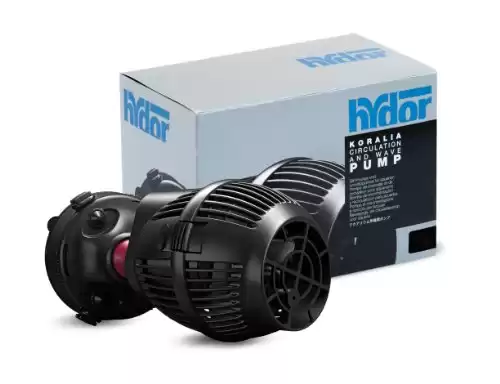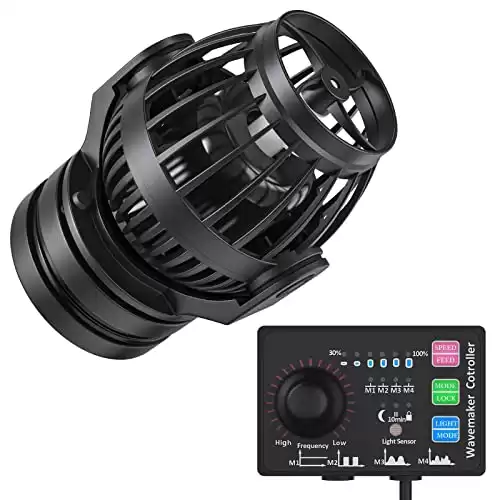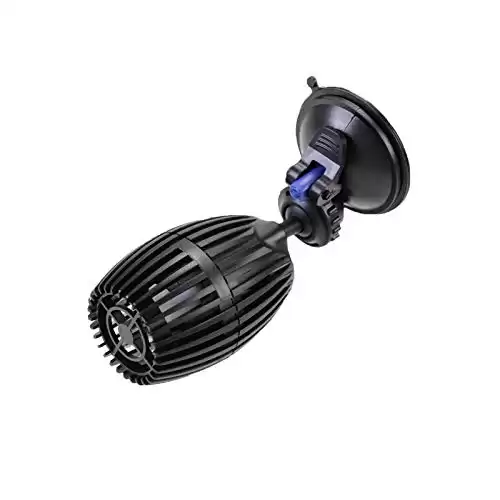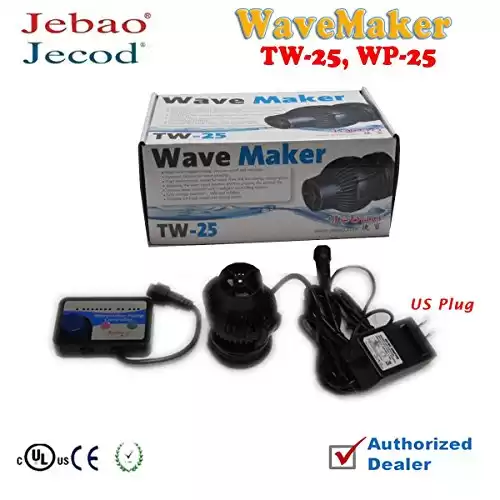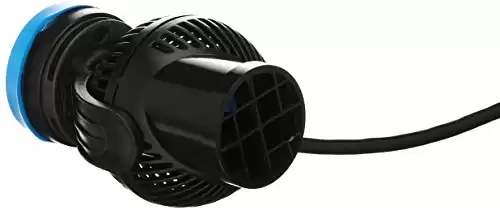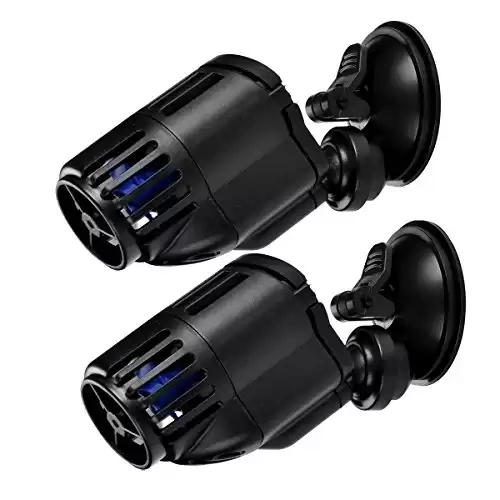Powerheads are essential in saltwater aquariums to recreate ocean currents and circulate water. In my first experience setting up a saltwater tank, I didn’t use a powerhead, and my fish was not happy.
|
Primary Rating:
4.4
|
Primary Rating:
4.3
|
Primary Rating:
4.3
|
I was on the hunt for the best powerhead for my saltwater tank. I tried a bunch of different ones, but none of them seemed to work quite right. The current wasn’t strong enough, or the water wasn’t circulating evenly.
After trying over dozen different powerheads, I’ve compiled a list of the best powerheads for saltwater tanks.
In this guide, I’ll share with you the best powerheads, which ones made the cut, and what to look for when choosing one for your tank!
Does a Saltwater Tank Need a Powerhead?
A saltwater aquarium uses a powerhead to circulate water throughout and between the tank and other equipment, such as protein skimmers. In addition, they provide similar water movement in oceans from surface waves to surges or swells.
Due to the continuous movement of waves, tides, and currents, the oceanic waters are never still. As a result, most saltwater fish and corals have adapted to living in water with some sort of this water current flow.
What Is the Difference Between a Powerhead and a Wavemaker?
Water Powerheads and wavemakers function similarly, moving water about your aquarium. The distinction between the two is how the water motion is achieved.
A powerhead produces a steady water flow pattern, whereas a wavemaker generates a pulsing flow, wave-like motion.
Is a Powerhead a Filter?
Powerhead is a filter, more specifically, a mechanical filter. A powerhead will move water through a sponge or other media to remove debris and residues from the water column.
Many powerheads on the market today come equipped with an integrated filter, making them an all-in-one solution for water circulation and filtration.
Best Powerheads for Saltwater Tanks
Hydor Koralia Evolution
- New shaft-less impeller technology with flow rate of 600 gph ideal for tanks from 40 to 80 gallons, fresh or marine water
- Sphere joint: adjustable flow direction
The Hydor Koralia Evolution Aquarium Circulation Pump series from Hydor consists of four models, each with a Gallons Per Hour rating. The least expensive single unit creates 550 to 600 GPH, the next 750 to 850 GPH, the third 1050-1150 GPH, and the top-of-the-line model 1400 to 1500 GPH.
Hydor also offers a wide range of sizes up to 175 gallons, so you’re sure to find a model that will suit your needs without a hassle!
What I like most about Hydor Koralia Nano Aquarium Circulation Pump is the twin magnet and suction cup mounting system, which minimizes vibrations and noise. Plus, it uses low energy, so your power bill won’t be through the roof.
What We Like
- Efficient
- Low energy use
- Quiet
- It comes with an integrated filter
Room for Improvement
- It can be challenging to place in some tanks
Jebao WP-25 Wavemaker
- Flow rate from 800GPH to 2000GPH
- Power - 110V to 240V 50/60Hz
- Wattage - 12W depending on the mode
- Size – body dia 70×90mm; outlet 40mm
Jebao has several styles and sizes of the powerhead to suit your needs, like the WP-10, WP-25, WP-40, and WP-60. The number in each model refers to the wattage output.
The larger the number, the larger the fan and the more water it can circulate. Unless your fish like strong currents, don’t go for these powerheads in a small tank.
The WP powerhead series has several power options. For the WP1 option, the pump generates a pulsating flow that allows for back-and-forth movement.
WP2 and WP3 settings create different flow patterns by speeding up and slowing down the pump intermittently to create a wave-like effect.
I appreciate that the Jebao powerheads come with a controller. This gives you the option to adjust the flow direction without having to buy additional devices. The model also has easily accessible aquarium accessories for aquarium care.
What We Like
- It comes with a controller
- Customizable wave patterns
Room for Improvement
- Some models are too strong for small tanks
Tunze USA Nano Stream
- Quiet Operation
- 3D Adjustability
- Strong Magnet Mount with C Clamp
Tunza USA Nano Stream is a variable-speed powerhead that can handle up to 135 gallons of tanks.
Despite its compact size, this powerhead is highly adaptable and can produce between 400 and 1,175 GPH, making it one of the most flexible on the market.
Similar to Hydo Koralia Evolution, this powerhead has a magnetic base unit and a cup to minimize the noise emitted by the unit.
Also, you can direct the magnet mount as you like, giving you plenty of options for where the pump emits water. I adjusted the pump for my reef tank to better fit my demands efficiently.
What We Like
- Variable speed control
- Quiet
- Directional flow
Room for Improvement
- Only one size
- Pricey
Uniclife Controllable Wave Maker
- Adjustable Water Flow: Max flow rate: 2100 GPH; Power: 25 W, Voltage: DC 24 V. A powerful circulator for 60-120 gallon aquariums, fish tanks or ponds.
- 4 Optional Waves: Press the “mode” button to switch between 4 wave modes (M1/M2/M3/M4). Easily achieve multiple sea waves with a simple controlling panel.
The Uniclife UL210 submersible water pump has a maximum flow rate of 2100 GPH, which is appropriate for tanks between 20 and 60 gallons.
This product only consumes 23 W of power, so you don’t have to worry about it overworking your electrical system or breaking the bank.
The UL210 has magnetic suction cups that allow you to attach them to various locations inside your fish tank. This gives you more control over the internal flow rate and direction.
You can use the UL210 for various tasks, such as controlling the water flow speed with a 360-degree rotation. This means you can target any area in the fish tank and pump water to wherever you want it to go.
In fact, my fish love it when I direct the flow towards them, and they often swim against the current!
What We Like
- It can be used for a variety of purposes
- Controls are easy to use
- More advanced features if needed
- Low noise devices
- Adjustable flow rate
Room for Improvement
- Too powerful
SUN 2 Piece Circulation Powerhead
- Wide-spread range which is ideal for freshwater or marine aquarium
- Totally submersible and oil-free motor to avoid pollution to the living circumstance
- 360 degree rotation to allow full flow directions
JVP Series has three power options: 530 GPH, 800 GPH, and 1,300 GPH, so you can find the perfect size for your saltwater reef aquarium. The 1,300 GPM unit only comes in a 4-pack, but you still can choose between the other two models.
You can purchase one of the powerheads from the 530 or 800 series or buy multiple units and daisy chains them together. Whatever you choose, you will have a pump that works with any aquarium size.
In addition, the JVP Series powerhead includes a 360-degree rotation on a ball joint mount to provide any part of your aquarium with the desired water circulation.
The fan on this device is loud, but the suction cup connection to the glass tank can reduce the fan’s noise level, which is a nice bonus!
Before using the JVP Series, I always worried that my fish would get ill from oil or metal-based products. However, since the JVP is oil-free, I don’t have to worry about that anymore.
What We Like
- Oil-free
- Low-cost
- Easy to use
- Controllable flow rate
- Quiet
Room for Improvement
- The fan is dangerous for fish
Aquaneaut Circulation Pump
- Flow Rate: 480GPH (1850L/H), ideal for 60 gal freshwater tank or 30 gal saltwater tank.
- Enhance Filtration: 360° rotation flow directions make it easy to stir up small particles and leftover food to be picked up by the filter eliminating dead spots.
The Aquanaut circulation pump is new in the market and has a very affordable price. It has different sizes available, from a 480GPH (ideal for 30-60 gallon reef tanks) to a 2100GPH (usable in aquariums up to 150 gallons).
If you’re looking for an affordable way to improve water circulation in your reef tank, any of these powerheads will do the trick.
When I first tried this powerhead, I kept an eye on my fish since I was worried the current might be too strong for them. Not only didn’t they seem to bother them, but they also enjoyed the reverse flow feature!
What We Like
- Affordable
- Different sizes available
- Perfect for smaller reef tanks
Room for Improvement
- Not as customizable as other options
When Selecting a Powerhead, What Are the Most Important Things To Consider?
Flow Rate
The flow rate is how many gallons of water go out of your powerhead each hour. Depending on the type of coral you are planning to keep, you can decide the optimal flow rate for your tank.
If soft and LPS corals are in your aquarium, you will need a max flow rate of 10 to 20 times per hour. To figure out the ideal turnover, divide the GPH number on your powerhead by your whole tank volume.
From another viewpoint, a 30-gallon reef aquarium running on a 600GPH power supply would have an optimal water turnover of 20x (600 / 30 = 20).
On the other hand, SPS corals need much stronger water currents. Therefore, you should aim for a more powerful powerhead with a healthy flow rate of 20 to 40 times per hour.
Size
Powerheads are often bulky, making them difficult to conceal in reef tanks. You usually have to point them in a specific direction, so you can’t always choose where they go.
I think it is worth paying a little more for an aquarium powerhead with a smaller size to keep your tank’s aesthetics in check. Who wants an eyesore in their perfect underwater paradise?
Brands
I don’t like being excessively fussy regarding price when combining electricity and water. This includes filters, heaters, protein skimmers, pumps, and other equipment.
I have had previous experiences with cheaper aquarium equipment breaking down and flooding my house. Therefore, I only buy aquarium products from reliable brands that I trust.
While you think you’re saving money buying that $15 powerhead on Amazon, you may have to replace it twice before you would’ve spent the same amount on a quality product!
How Do You Set Up Powerheads in a Saltwater Tank?
For a nano tank, you can use a single powerhead at the end of the tank to generate a river-like current.
From my point of view, an flow rate distribution of at least 6 tank rotations per hour is ideal. Previously, 10 revolutions of water in the aquarium per hour was considered adequate. Still, experts are now claiming that an estimated flow rate of 20 times per hour is better.
Instead, you can install two powerheads at opposite ends of the tank to create a wave-like water current.
In medium tanks, you should use two or three powerheads at different points in the tank for optimal flow.
For two heads, position them at opposite ends of the tank. For three heads, position them in opposing positions around the tank’s perimeter. When using four powerheads, place one in each corner of the aquarium.
It would be best to have more powerheads for large tanks to ensure even water circulation throughout the aquarium. You can tell if the flow is adequate by watching how the fish and coral react.
What Are the Advantages of Using an Aquarium Powerhead?

From our years of experience as aquarium enthusiasts, we have found that using a powerhead has many benefits. Some of the advantages of using a powerhead in your aquarium are:
- Creates a constant water flow
- It prevents stagnant water that can become a breeding ground for bacteria
- Reduces the amount of algae growth in your aquarium by circulating nutrients
- It helps to aerate the water and prevent low oxygen levels
- Creates a natural environment for your fish that replicates their natural habitat
- Stimulates the growth of corals and other marine life.
- It prevents debris from settling on the bottom of the tank
- It helps to distribute the heat emission evenly throughout the aquarium
FAQs
How Much Flow Does a 75-Gallon Reef Need?
Depending on the kind of coral you keep in your 75-gallon reef tank, you can use a flow rate between 1500 and 3000 GPH.
How Much Flow Do I Need for My 10-Gallon Nano Reef Tank?
Depending on the coral type in your 10-gallon nano fish tank, you can use a water flow rate of 20 to 40 times.
How Much Flow Do I Need for My 20–30 Gallon Coral Reef Aquarium?
Depending on the reef tank size and your coral reef aquarium type, you should have a water flow rate ranging from 400 to 1200 GPH. According to the standard, LPS corals need 20 times the total volume turnover, while SPS corals need 40x.
How Much Flow Do I Need for My 40-Gallon Reef Tank?
If your 40-gallon reef aquarium is home to mostly LPS coral reefs, you’ll need a powerhead pump that can move at least 800 gallons per hour.
How Much Flow Do I Need for My 55-Gallon Reef Tank?
In the case of LPS corals, a 55-gallon reef aquarium requires 20 times the flow of water, while SPS corals need 40x. For a reef aquarium with primarily LPS Corals, a flow rate of 1100 GPH is ideal.
How Much Flow Do I Need for My 90-Gallon Reef Aquarium?
A reef 90-gallon aquarium should have a pump capable of at least 900 GPH. However, suppose the primary occupants in the tank are LPS corals. In that case, you will need a more powerful pump with a total output of 1800 GPH.
For an SPS reef with a water capacity of 90 gallons, you should have 3600 GPH.
Do Powerheads Oxygenate Water?
Powerheads do oxygenate water since they create water movement. The oxygenated water will rise to the surface and exchange with the air in the room, providing more oxygen to the tank.
Do Fish Like Powerheads?
All fish are like powerheads because they provide a natural current in the tank. Also, the flow helps carry food and oxygen around the tank, replicating their natural environment.
Wrapping Up
As you can see, using a powerhead in your aquarium has many benefits. Not only does it help to oxygenate the water and distribute food, but it also replicates the fish’s natural environment.
If you have any questions, please feel free to comment below. I would be happy to help!


